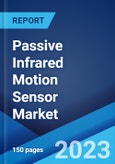Passive infrared (PIR) motion sensors are electronic devices that detect moving objects or individuals based on changes in infrared radiation emitted by living beings and other heat-emitting sources. These sensors operate on the principle that objects emit infrared radiation as heat. When a moving object enters the sensor's field of view, it causes a change in the infrared energy pattern detected by the sensors. The PIR sensor then generates an electrical signal, which can trigger various actions, such as activating an alarm or video recording, adjusting the intensity of lights, and regulating heating, ventilation, and air conditioning (HVAC) systems, based on occupancy. They offer numerous advantages, such as quick response time, low power consumption, and cost-effectiveness. As a result, they are widely employed in homes, offices, commercial buildings, outdoor spaces, and public areas for security, lighting control, and energy management applications.
Passive Infrared Motion Sensor Market Trends:
The growing adoption of smart home systems that utilize motion sensors for security, lighting control, and energy management represents one of the prime factors driving the market growth. Besides this, the proliferation of the Internet of Things (IoT)-based devices and the need for smart connectivity are contributing to the market growth as PIR motion sensors enable automation and interaction among these devices. Moreover, the escalating consumer concerns regarding safety and security are fueling the demand for enhanced intrusion detection systems and surveillance cameras integrated with PIR motion sensors, thus favoring the market growth. In addition to this, governments and organizations worldwide are emphasizing the adoption of energy-efficient solutions, leading to the integration of PIR motion sensors in lighting systems to enable automated control and energy savings, which, in turn, is creating a positive outlook for the market. Concurrent with this, the rising product utilization across retail and commercial spaces is acting as a significant growth-inducing factor. Furthermore, ongoing advancements in PIR sensor technology, including improved sensitivity, reduced false alarms, and enhanced detection range, are aiding in market expansion. In line with this, the integration of innovative technologies, such as wireless connectivity, voice control, and artificial intelligence in PIR motion sensors to provide enhanced functionality, is presenting remunerative growth opportunities for the market. Other factors, such as rapid urbanization and infrastructure development of smart cities and buildings, extensive product adoption in the automotive, aerospace, and defense industries, and favorable government regulations promoting environmental sustainability, are propelling the market forward.Key Market Segmentation:
The publisher provides an analysis of the key trends in each segment of the global passive infrared motion sensor market, along with forecasts at the global, regional, and country levels from 2025-2033. Our report has categorized the market based on type and application.Type Insights:
- Single Beam Type
- Multi-Beam Type
Application Insights:
- Security Application
- Commercial Application
- Smart Home Application
- Military and Defense Application
Regional Insights:
- North America
- United States
- Canada
- Asia Pacific
- China
- Japan
- India
- South Korea
- Australia
- Indonesia
- Others
- Europe
- Germany
- France
- United Kingdom
- Italy
- Spain
- Russia
- Others
- Latin America
- Brazil
- Mexico
- Others
- Middle East and Africa
Competitive Landscape:
The report has also provided a comprehensive analysis of the competitive landscape in the global passive infrared motion sensor market. Detailed profiles of all major companies have been provided. Some of the companies covered include Elmos Semiconductor SE, Honeywell International Inc., Panasonic Holdings Corporation, Robert Bosch GmbH, etc. Kindly note that this only represents a partial list of companies, and the complete list has been provided in the report.Key Questions Answered in This Report:
- How has the global passive infrared motion sensor market performed so far, and how will it perform in the coming years?
- What are the drivers, restraints, and opportunities in the global passive infrared motion sensor market?
- What is the impact of each driver, restraint, and opportunity on the global passive infrared motion sensor market?
- What are the key regional markets?
- Which countries represent the most attractive passive infrared motion sensor market?
- What is the breakup of the market based on the type?
- Which is the most attractive type in the passive infrared motion sensor market?
- What is the breakup of the market based on the application?
- Which is the most attractive application in the passive infrared motion sensor market?
- What is the competitive structure of the global passive infrared motion sensor market?
- Who are the key players/companies in the global passive infrared motion sensor market?
Table of Contents
Companies Mentioned
- Elmos Semiconductor SE
- Honeywell International Inc.
- Panasonic Holdings Corporation
- Robert Bosch GmbH
Methodology

LOADING...
Table Information
| Report Attribute | Details |
|---|---|
| No. of Pages | 140 |
| Published | March 2025 |
| Forecast Period | 2024 - 2033 |
| Estimated Market Value ( USD | $ 11.5 Billion |
| Forecasted Market Value ( USD | $ 29.3 Billion |
| Compound Annual Growth Rate | 11.0% |
| Regions Covered | Global |
| No. of Companies Mentioned | 4 |









